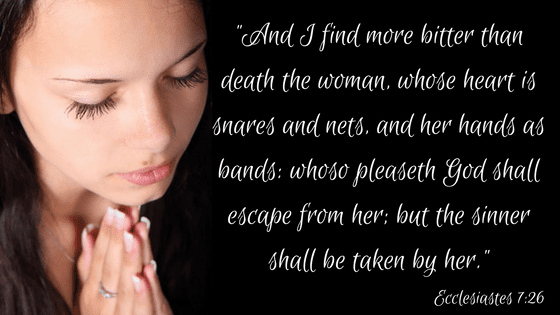The Bible and Christianity have treated women pretty poorly.

Aren’t you a believer? Let me “skim the surface” for you.
The Bible, used by most Protestants, consists of 66 books written in three languages (Hebrew, Aramaic and Greek) over about a 12-century interval by about 42 different individuals who lived on three continents. All, or essentially all, of the authors are believed to have been men.
A few theologians have suggested that the authors of Ruth, Hebrews, and particularly the Gospel of Luke may have been female. However, they are in the minority.
Passages about Women in the Hebrew Scriptures (a.k.a. Old Testament)
Women were frequently treated negatively and inferior to men.
Their behavior was often restricted:
From Ecclesiastes 7:26:
“And I find more bitter than death the woman, whose heart is snares and nets, and her hands as bands: whoso pleaseth God shall escape from her; but the sinner shall be taken by her.”
From Ecclesiasticus 25:13 and 18 in the Apocrypha.
“[Give me] any plague, but the plague of the heart: and any wickedness, but the wickedness of a woman. … Sin began with a woman and thanks to her we all must die.”
Note: Ecclesiastes is a collection of writings that were in the original King James Version of the Bible. They remain in Roman Catholic translations of the Bible but are not usually present in Protestant versions
The belief that “sin began with a woman” is a clear reference to Eve in the Garden of Eden eating the forbidden fruit of the Tree of Knowledge of Good and Evil.
In the Christian Scriptures (a.k.a. New Testament)
Women and men were frequently treated as equals, at least in the early Christian movement:
From Galatians 3:28:
“There is neither Jew nor Greek, there is neither bond nor free, there is neither male nor female: for ye are all one in Christ Jesus.”
From Timothy 2:5:
“There is one God and one mediator between God and humanity, the human Christ Jesus.
In Romans 16:7, the author Paul refers to a male apostle Andronicus and a female apostle Lunia as being “outstanding among the apostles” (NIV)
In 1 Corinthians 16:3, Paul described a married couple: Priscilla & Aquila as his fellow workers in Christ Jesus.
In Philemon 2, Paul directs a letter to “Apphia, our sister” and two men as leaders of a house church.
Treatment of women during Old Testament times
Women’s behavior was severely limited. Before marriage, they needed the permission of their father to leave the house. After marriage, they needed their husband’s permission.
They weren’t allowed to testify in court.
They couldn’t talk to strangers.
They had to be heavily veiled when outside their home.
They weren’t eligible to enter the priesthood.
Men could enter polygamous marriage involving multiple women. Women weren’t allowed to engage in polyandry by marrying multiple men.
A father could sell his daughter as a slave. In addition to this, although male slaves were automatically released after six years, a woman remained a slave for life.
Leviticus 27:6 explains that a boy under to five years of age was worth 5 shekels, whereas, a girl was worth 3 shekels.
Deuteronomy 22:13-21 explains that women who were found to not be virgins when they married would be stoned to death. There was no similar treatment for men.
Numbers 5:11-31 describes a magical temple ritual. If a husband suspected that his wife had an affair, the priest prepared a potion composed of holy water mixed with sweepings from the floor of the tabernacle. He proclaimed a curse over the potion and required the woman to drink it. If she was guilty, it was believed, that her abdomen would swell and her thighs waste away. There is no similar magical test for husbands.
Men could divorce their wives, but wives were not allowed to divorce their husbands.
How Yeshua of Nazareth (a.k.a. Jesus Christ) treated women
He accepted women as equal to men.
He ignored many of the customs of the day by not following ritual impurity laws; talking to foreign women; accepting women as close followers, and leaders, etc. In many of his parables, he told parallel episodes: one involving a man, the other a woman.
Some writings dated from the first few decades after Yeshua’s execution described Mary Magdalene and other women as being leaders in the movement.
Later Christian theologians’ treatment of women
In many cases, they reverted once more to treating women as inferior.
Thomas Aquinas wrote in “Summa Theologica,”Q92, Art. 1, Reply Obj. 1:
“As regards the individual nature, woman is defective and misbegotten, for the active power of the male seed tends to the production of a perfect likeness in the masculine sex; while the production of a woman comes from defect in the active power.”
Martin Luther, at the time of the Reformation, wrote:
“Women … have but small and narrow chests, and broad hips, to the end that they should remain at home, sit still, keep house, and bear and bring up children.”
Also:
“If they become tired or even die, it does not matter. Let them die in childbirth — that is why they are there.”
The views presented on this blog are an extension of those presented on the Religious Tolerance website. The purpose of all articles is to compare the full range of beliefs and actions by people who are members of various faith groups within Christianity and other world religions, individuals who are NOT Affiliated with a faith group (NOTAs), and secularists.















